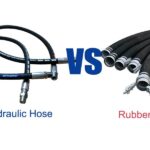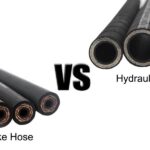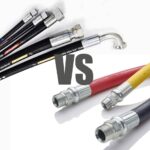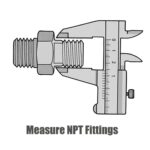Forklift Hydraulic Hose
Forklift Hydraulic Hoses: Key Components of Hydraulic Systems
Forklift hydraulic hoses are vital parts of the hydraulic system. They bring fluid from one location to an additional, enabling the forklift to perform its functions efficiently. These hoses generally wear after 1-2 years of use. They can additionally fall short due to variables like wear and tear, corrosion, inadequate routing, high temperatures, and utilizing the incorrect hydraulic fluid.
Forklift Hydraulic Systems
Forklifts have complex hydraulic systems, frequently electronically regulated much like the grip system. Allow's have a look at the essential components of a hydraulic system. A forklift hydraulic hose consists of an inner tube that carries the fluid and remains in direct contact with the hydraulic liquid. The rubber or synthetic products used for this purpose demand to be suitable and able to stand up to the functioning temperature level range without losing their chemical and physical security.
Materials for Forklift Hydraulic Hoses
Hydraulic hoses can be made from various materials depending on the oil compatibility, wear resistance, and other factors. Different hose types and fittings are used in forklift designs to meet specific requirements.
Sinopulse: Your Forklift Hydraulic Hose Manufacturer
Sinopulse is a leading manufacturer of forklift hydraulic hoses, providing a wide range of options for both standard and more complex applications. We offer hoses specifically designed for high-pressure environments, hoses with unique bend radii, and hoses made from materials like rubber, thermoplastics, and PTFE (Teflon). All of our forklift hydraulic hoses meet international standards.
Need to Replace Forklift Hydraulic Hoses?
We provide a variety of hydraulic hoses suitable for different types of forklifts and applications. As experts in forklift hydraulic hoses, Sinopulse guarantees quick delivery for all orders.
If you are unsure which forklift hydraulic hose is best for your needs, feel free to contact us! Our knowledgeable team is ready to assist you. We can provide hydraulic hoses for any forklift brand and model. Designed to perform in high-pressure environments, our hydraulic hoses ensure reliability and durability for your applications.
Sinopulse’s forklift hydraulic hoses are perfect for forklifts and material handling applications that require compact, highly flexible hoses. With a smaller outer diameter and excellent cold-weather flexibility, they improve operability and ease of installation.
Available Size of Forklift Hydraulic Hose
| Code | Size | Inside Diameter | Outside Diameter | Working Pressure | Bursting Pressure | Bend Radius | ||||
| # | Dash | mm | Inch | mm | mm | bar | psi | bar | psi | mm |
| SNP-R1604 | R16-04 | 6.4 | 1/4" | 6.2-7.0 | 14.5 MAX . | 225 | 3263 | 900 | 13050 | 50 |
| SNP-R1605 | R16-05 | 7.9 | 5/16" | 7.7-8.5 | 15.7 MAX . | 215 | 3118 | 860 | 12470 | 55 |
| SNP-R1606 | R16-06 | 9.5 | 3/8" | 9.3-10.1 | 18.8 MAX . | 180 | 2610 | 720 | 10440 | 65 |
| SNP-R1608 | R16-08 | 12.7 | 1/2" | 12.3-13.5 | 22.0 MAX . | 160 | 2320 | 640 | 9280 | 90 |
| SNP-R1610 | R16-10 | 15.9 | 5/8" | 15.5-16.7 | 25.4 MAX . | 130 | 1885 | 520 | 7540 | 100 |
| SNP-R1612 | R16-12 | 19.1 | 3/4" | 18.6-19.8 | 29.0 MAX . | 105 | 1523 | 420 | 6090 | 120 |
| SNP-R1616 | R16-16 | 25.4 | 1" | 25.0-26.4 | 36.6 MAX . | 87 | 1262 | 348 | 5046 | 150 |
| SNP-R1620 | R16-20 | 31.8 | 1-1/4" | 31.4-33.0 | 44.3 MAX . | 63 | 914 | 252 | 3654 | 210 |
What type of hydraulic hoses on forklift
| Hose Type | SAE/EN Standard | Typical Use | Features |
|---|---|---|---|
| SAE 100R1AT / EN 853 1SN | Medium-pressure | Lift and tilt cylinders | Single steel wire braid, flexible |
| SAE 100R2AT / EN 853 2SN | High-pressure | Lift/tilt, steering | Two steel wire braids, durable |
| SAE 100R5 | Medium-pressure | Return lines, older forklifts | Textile braid cover, good for tight spaces |
| SAE 100R7 / R8 (Thermoplastic) | Medium-pressure | Electric forklifts, low weight needs | Lightweight, abrasion-resistant, non-conductive |
| EN 856 4SP / 4SH | Ultra high-pressure | Heavy-duty forklifts | 4-spiral wire, very high pressure tolerance |
Typical Hose Applications on a Forklift
-
Lift Cylinder Hoses – Carry high-pressure fluid to raise/lower the forks.
-
Tilt Cylinder Hoses – Control tilt movement of the mast.
-
Side Shift/Attachment Hoses – For special functions like clamps or rotators.
-
Power Steering Lines – Smaller diameter, flexible hoses for steering assist.
How to Replace Forklift Hydraulic Hose
If you own or operate a forklift, you know how crucial it is to maintain and run it efficiently. One part of the hydraulic system, often several parts, is vital to keeping your forklift running smoothly — the hoses. Over time, these hoses can wear out or get damaged, leading to leaks and other issues. When this happens, make sure to replace them as soon as possible to avoid costly downtime.
When to Replace Forklift Hydraulic Hoses
- Fluid Leaks: If you notice hydraulic fluid leaking from the forklift, it’s a sign that the hoses may have a problem. Seek help or take action immediately to prevent further issues.
- Cracks or Wear: Inspect the forklift’s hoses for signs of cracks, wear, or damage. If you spot any, it’s time to replace them. If you’re unsure, it’s best to consult a professional.
- Low Fluid Levels: If you find yourself regularly topping up hydraulic fluid, it might indicate that the hoses are leaking. This should be addressed promptly to prevent further problems.
How to Choose Forklift Hoses
Pressure Rating: Must handle the system’s max pressure + a safety margin.
Flexibility: Important due to constant movement during lifting/tilting.
Abrasion Resistance: Outer layer should resist rubbing/contact wear.
Chemical Resistance: To withstand hydraulic oil and occasional exposure to fuel or cleaning agents.
Temperature Range: Should tolerate cold starts and hot working conditions.
How to Inspect Forklift Hydraulic Hoses to Prevent Future Failures
Understanding what caused the hose failure is essential. If the hoses have served you for many years and are simply showing signs of age, that’s no problem. However, if the hoses fail prematurely, external factors might be to blame. In such cases, identifying the cause can help ensure that the replacement hoses last longer.
A simple method is to have your forklift operators complete a safety checklist before every shift. They should ensure that all critical components, including hydraulic hoses, are functioning properly. Operators should check for the following:
- No kinks, bends, or other signs of wear
- No dry, cracked patches on the hoses, cracks in fittings, or visible leaks at startup
- Missing or damaged clamps that secure hoses in place
- Hoses dragging or loosely riding over pulleys and rollers
This checklist not only ensures the safety of your operators but also helps spot any early signs of hose wear. Catching problems early can prevent them from worsening. For example, if an operator notices hose degradation within a year, they can identify if the hose is overheating, vibrating excessively, or bending at extreme angles. Addressing these issues early prevents further damage to the forklift hydraulic hoses.









